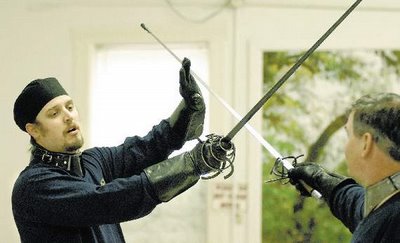The Art of Fencing

Credit: Denise Baratta, mailtribune.com
Matthew Howden and Jeff Richardson face each other with rapiers crossed. They move with great economy, each adjusting to the other, neither willing to strike until he has a clear advantage. The men's feet trace wide arcs on the floor of the Phoenix Grange Hall as steel scrapes on steel.
Then, almost too fast for the eye, Howden has caught Richardson's rapier on his hilt, and Richardson is in a kneeling position with a blade at his throat.
The two men, both instructors with the Academia Duellatoria, are facing off in a weekend seminar devoted to the work of Gerard Thibault d'Anvers, a master swordsman whose seminal "Academy of the Sword" was published in 1630.
The idea for the weekend is for the seven or eight men standing against the wall and sitting on a nearby bench to learn the underpinnings of Thibault's system and practice its techniques. As with most martial arts, there's more than meets the eye.
Historic fencing looks different from both Olympic-style sport fencing and the fight choreography of the modern stage, a la "The Three Musketeers." It often takes but a small move to change the dynamics of what in former times was a deadly dance. Richardson demonstrates as he and Howden cross blades with the latter's sword pointing at the former's face.
"Danger," Richardson says, rotating his wrist a hair counter-clockwise. "Out of danger."
The slight action leaves his blade pointed at Howden, and the other man's rapier aimed harmlessly over Richardson's left shoulder.
Richardson, 39, who does architectural design in his day job, was one of the founders of the Academia several years ago. It operated at Southern Oregon University in Ashland and at the Medford Elks. He's moved it to Portland, but an affiliated group remains in Southern Oregon.
Thibault is one of the group's main interests. John Michael Greer, of Ashland, published a new translation of Thibault's work two years ago.
Thibault believed that the rapier alone was sufficient for hand-to-hand combat without any other weapons. The rapier was developed in the 16th and 17th centuries for self-defense and dueling. It is an edged weapon with a complex hilt used for both thrusting and cutting.
"The basic premise is to get the other guy's weapon down here at the junction of the hilt and the forte," Richardson says, hefting a practice rapier with a blunted point.
The hilt comprises a knuckle guard and a series of loops between the weapon's handle and its blade. The forte is the relatively thick, strong part of the blade nearest the hilt.
Thibault's system stresses the idea of the decision point. One of the first decisions in a duel has to do with the question of depth. For example, has anybody's point passed the other's guard?
If not, there are certain options. Passing that point can mean the difference between needing to make a slight movement or a complex one. In this art, tempo is the amount of time it takes to perform an action. And an action that takes less time will usually defeat an action that takes more time.
"So I'm trying to set up a situation where all my opponent's actions take more time than mine," Richardson says.
He says the principles learned with the rapier have broader applications. Travis Harden agrees. Harden, 29, has a black belt in karate and teaches at Chip Wright's school in Medford.
"The rapier is 90 percent footwork," he says. "I can apply those same movements to karate."
The way Richardson puts it is that if Asian martial arts are about meditation, fencing is about geometry. Thibault and other masters created an elaborate geometry of movement. This Pythagorean, or sacred, geometry was connected, along with the rest of math and science, to an elaborate system of philosophy and theology in which everything was part of a grand design.
Read more: mailtribune.com

0 Comments:
Post a Comment
Subscribe to Post Comments [Atom]
<< Home